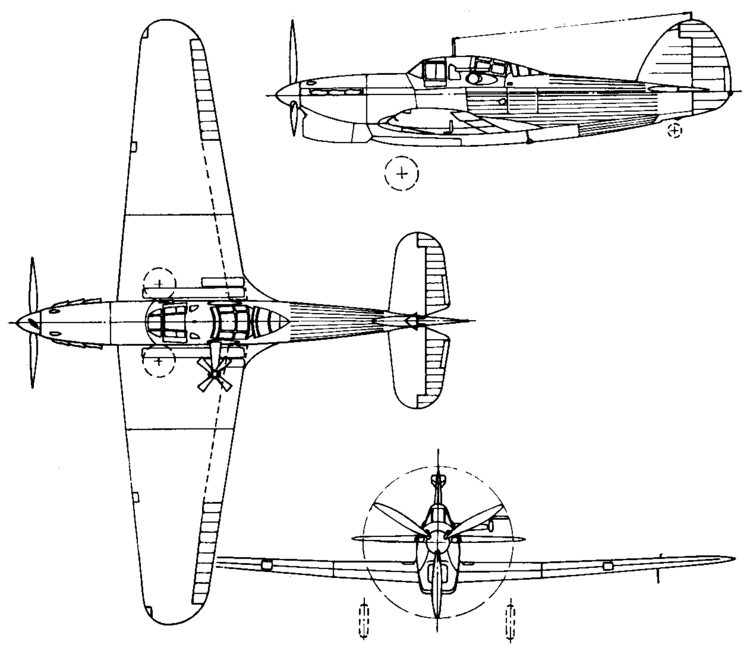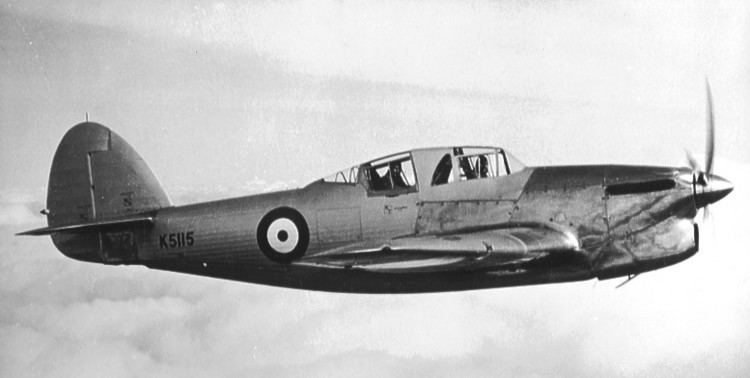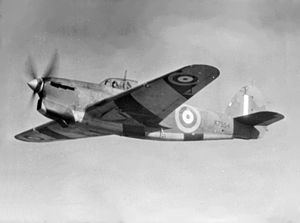Wingspan 15 m Introduced 1938 First flight March 10, 1937 Designer Sydney Camm | Length 11 m Retired 1942 | |
The Hawker Henley was a British two-seat target tug derived from the Hawker Hurricane that was operated by the RAF during the Second World War.
Contents

Design and development
In 1934 Air Ministry Specification P.4/34 was issued which called for a light bomber that could also be deployed in a close-support role as a dive-bomber.

(While this suggests a departure from Air Ministry policy which placed great emphasis on strategic bombing, the RAF had always had two-seat light bombers in its armoury – notably the DH4 and DH9a in World War I and a host of types in the 1920s leading to the fast Fairey Fox, Hawker Hart, and Hawker Hind – which suggests P.4/34 was issued to identify a modern equivalent for RAF two-seat day-bomber squadrons that had attacked railways and trains bringing supplies to the front line from 1915 in World War I.)

Fairey, Gloster and Hawker all rushed to fulfil this need and competition was tight to attain the highest performance possible. As the aircraft required only a modest bomb load and with performance being paramount, the Hawker design team chose to focus its efforts on developing an aircraft similar in size to their Hurricane fighter.

The Hurricane was then in an advanced design stage and there would be economies of scale if some assemblies were common to both aircraft. This resulted in the Henley, as it was to become known, sharing identical outer wing panel and tailplane jigs with the Hurricane. Both were equipped with the Rolls-Royce Merlin engine as it offered the best power-weight ratio as well as a minimal frontal area. The Henley’s cantilever fabric-covered monoplane wing was mid-set, a retractable tail wheel landing gear was selected and accommodation provided for a pilot and observer/air gunner, which differed from the Hurricane’s single-seat cockpit.
Although construction of a Henley prototype began as early as mid-1935, with priority given to Hurricane development, it was not until 10 March 1937 that, powered by a Merlin "F" engine, it was first flown at Brooklands, shortly after the competing Fairey P.4/34. Subsequently the aircraft was refitted with light alloy stressed-skin wings and a Merlin I engine (production version of the F) and further test flights confirmed the excellence of its performance. It could reach a top speed of 300 mph (480 km/h).
However, at this point the Air Ministry had by this point decided that it no longer required a light bomber (probably because this role was felt to be adequately filled by the Fairey Battle). Accordingly the Henley, which in line with RAF policy had not been fitted with dive brakes; bomb crutches; or specialised bomb sights and thus limited to attack angles of no greater than 70° (and consequently far less accurate than specialised German dive bombers of the same period, notably the Ju87 Stuka, fitted with all of the foregoing and a semi-automatic bomb release and dive termination system and thus capable of near-vertical dives of pin-point accuracy) was relegated to target-towing duty.
Henley production was subcontracted to Gloster Aircraft and 200 were ordered into production.
The second prototype was fitted with a propeller-driven winch to haul in drogue cable after air-to-air firing sorties. This was first flown on 26 May 1938.
Operational history.
Production aircraft, designated Henley III, entered service with Nos. 1, 5 and 10 Bombing and Gunnery Schools, as well as with the Air Gunnery Schools at Barrow, Millom and Squires Gate. Unfortunately, it was soon discovered that unless the aircraft were restricted to an unrealistically low tow speed of 220 mph (355 km/h), the rate of engine failures was unacceptably high, attributed to a cooling system matched to the Henley's original missions but inadequate when towing a target at high engine speed but lower airspeed.
As a result Henleys were withdrawn from this role and relegated to towing larger drogue targets with anti-aircraft co-operation units, predictably proving themselves even less well-suited to this role when the number of engine failures increased, problems with engines compounded by difficulties releasing drogue targets.
Several Henleys were lost after the engine cut out and the drogue could not be released quickly enough. A solution was never found to this problem and in mid-1942 the Henley was withdrawn from service, being replaced by adapted Boulton Paul Defiants and purpose-built Miles Martinets.
Variants
Operators
Specifications (Henley Mk III)
General characteristics
Performance
